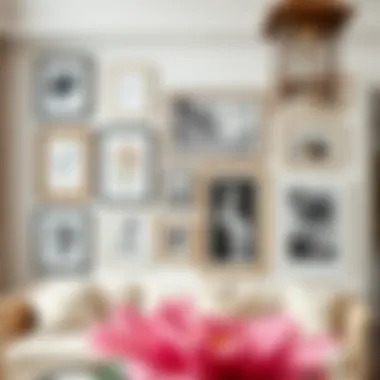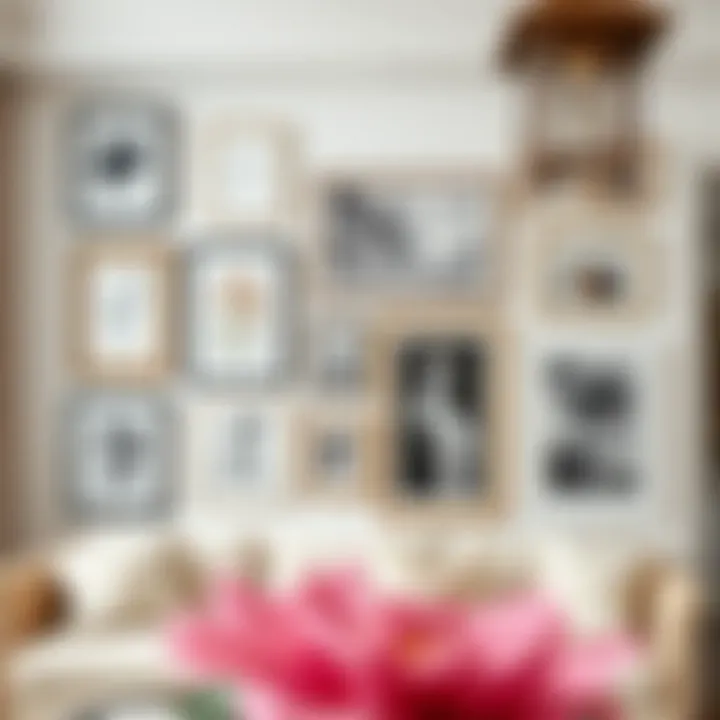Choosing and Arranging Picture Frames for Your Walls


Intro
Choosing and arranging picture frames for wall displays isn't just about hanging art on the wall; it’s a reflection of personal style and a way to showcase memories. In an age where interiors can make or break a home’s ambiance, understanding how to curate these pieces becomes essential. The delicate balance of alignment, color, and material can transform a simple wall into an eye-catching gallery.
Every frame tells a story. A well-chosen frame complements the artwork, adds depth, and can even change the viewer's perception of the piece. Today, as homeowners and decorators seek to tailor their spaces to reflect individuality, the art of framing becomes increasingly important. This guide will walk you through the nuances of selecting frames, arranging them effectively, and embracing modern trends while respecting timeless styles.
Let’s get started by diving into the latest design trends that inform today’s visual displays.
Understanding Picture Frames
Picture frames hold much deeper significance than merely serving as decorative borders for photographs or paintings; they act as conduits that enhance the aesthetic appeal of our living spaces. When we delve into the realm of interior design, frames play a pivotal role, teaming up with art to create an engaging narrative that reflects personality, style, and emotional resonance. Thus, understanding picture frames is essential for anyone looking to elevate their decor.
The Role of Picture Frames in Interior Design
Frames have the unique ability to draw attention to artwork and photographs, essentially transforming simple images into focal points. A well-chosen frame can complement the colors and themes in a room, or even act as a contrasting element that adds interest. For instance, placing a rustic wooden frame around a vibrant abstract painting not only enhances the painting itself but also integrates it within a farmhouse aesthetic.
Moreover, frames can create a cohesive story in a space. When thoughtfully arranged, they guide the viewer's eye and help create rhythm, making a wall feel curated rather than cluttered. Designers often highlight the arrangement of frames to echo the overall style of a room, whether that's vintage charm or sleek contemporary vibes.
Types of Picture Frames and Their Purposes
When it comes to picture frames, variety is the spice of life. Different frame styles serve different purposes and cater to a range of tastes. Here’s a closer look at some common types:
Traditional Frames
Traditional frames, often crafted from fine woods and characterized by ornate designs, exude a classic elegance. These frames typically feature intricate carvings or gilded finishes, making them a go-to choice for framing heirlooms or portraits. Their biggest advantage lies in their ability to add a touch of sophistication to any decor.
However, one must consider that traditional frames can sometimes weigh heavy both in terms of physical weight and visual impact, potentially overshadowing more subtle artwork. Additionally, they might require regular upkeep to maintain their pristine appearance.
Modern Frames
In contrast, modern frames provide a sleek, uncomplicated elegance. Generally made from materials like metal or acrylic, these frames embrace minimalism and clean lines, fitting seamlessly into contemporary interiors. They often emphasize the artwork without stealing the spotlight.
A key characteristic of modern frames is their versatility; they adapt well to various art styles, from vibrant pop art to muted landscapes. However, one must be cautious; a poorly chosen modern frame can sometimes feel sterile or uninviting in certain settings.
Shadow Boxes
Shadow boxes elevate the framing game by allowing for a three-dimensional display. These frames are deeper than standard ones and are designed to hold objects such as memorabilia or textile art. They bring a unique aspect of storytelling into framing, letting viewers peek into a curated vignette of personal history or creativity.
The standout feature of shadow boxes is their ability to create depth and interest on a wall. However, they may require a bit more attention during arrangement, as the included objects can demand specific lighting or spacing considerations to shine their brightest.
Collage Frames
Collage frames have surged in popularity as they offer a creative canvas to display multiple photos or artworks in one frame. They come in various shapes and configurations, allowing for a customizable approach to personal exhibitions. This type of frame serves as an excellent opportunity to showcase memories or a visual story.
The unique feature of collage frames is their capacity to create dynamic visual interest without overwhelming a wall. They do come with their own challenges; arranging images within them can be tricky. If not done thoughtfully, they can risk looking haphazard or cluttered.
Selecting the Right Materials
When it comes to framing artwork and photographs, the choice of material is paramount. Selecting the right materials not only affects the aesthetic appeal of your display but also the longevity and durability of the frames themselves. Whether you’re showcasing dear family memories or art pieces, the materials you choose can have a profound impact on how those pieces are perceived in your living space. A well-crafted frame can elevate even the simplest image, while a poor choice can overshadow the artwork's true beauty.
When thinking about materials, consider the environment in which the frame will live. Different materials respond to conditions like humidity and light differently, and this can affect both appearance and preservation. Wood frames often bring a warmth that invites nostalgia; metal frames provide a sleek, modern touch; meanwhile, plastic frames can offer versatility at an affordable cost. Each material has its perks and pitfalls.
Wood Frames: Advantages and Disadvantages
Wood frames are often seen as a staple in the framing world. They can create a warm and inviting feel that complements various decor styles. A rich mahogany frame might bring out the elegance in a portrait, while a weathered pine frame can add rustic charm to a landscape.
Advantages of wood frames include:
- Aesthetic appeal: They can suit various styles, from traditional to contemporary.
- Customizable finishes: Wood can be stained, painted, or left natural to fit the desired look.
- Durability: High-quality wood frames can last for decades when properly cared for.
However, there are some downsides:
- Cost: Well-made wooden frames can be pricier than their counterparts.
- Maintenance: Wood can warp or crack over time if subjected to extreme temperatures or humidity.
- Weight: Heavy framed artworks can be challenging to hang securely.
Metal Frames: Durability and Aesthetics
Metal frames stand as symbols of modernity and strength. They come in a variety of finishes like brushed aluminum or polished chrome, allowing for an attractive yet industrial look. An essential characteristic of metal frames is their longevity. They are far less likely to warp or bend when compared to wood, which makes them ideal for places with fluctuating temperatures.
Key benefits include:
- Durability: Resistant to physical and environmental wear.
- Sleek design: They provide a clean, minimalist aesthetic that suits modern art well.
- Lightweight options: Some metal frames are surprisingly light, making them easier to handle.


However, consider potential drawbacks:
- Limited insulation: Metal can get hot in direct sunlight, potentially damaging delicate artworks.
- Risk of scratches: While durable, metal surfaces can show scrapes more visibly than wood.
Plastic Frames: Cost-Effective Choices
Plastic frames have been often dismissed as inferior, but they can serve as surprisingly effective solutions for framing needs. Their affordability makes them appealing, especially for casual displays or use in environments where frames might be changed frequently, like in rental spaces or children’s rooms.
Benefits worth noting:
- Cost-efficiency: They are generally much cheaper than wood or metal frames.
- Weight: Lightweight and easy to manipulate, making them ideal for larger pieces.
- Variety of colors: Plastic frames come in various colors and styles, catering easily to personal aesthetics.
Some considerations include:
- Less durable: With time, they may fade or become brittle.
- Aesthetic limitations: They may not have the same perceived value as wood or metal options and can sometimes look cheaper.
In summary, choosing the right material for picture frames involves balancing aesthetics, budget, and durability. Each option has its own charm and limitations. By carefully considering the context in which the frame will be displayed, you can ensure that your choice not only showcases the artwork effectively but also enhances the overall decor of your space.
Framing Styles and Trends
Choosing the right picture frame goes beyond mere aesthetics; it speaks volumes about your style and the atmosphere of a room. This section will explore contemporary framing styles that are currently making waves in interior design. Understanding these trends is critical for anyone looking to create visually striking wall displays. Not only do they influence how your art or photographs are perceived, but they also contribute to the overall vibe of your space. From minimalist chic to vintage charm, becoming familiar with these styles can guide you in making choices that resonate with your personal taste and the environment.
Minimalist Frames: A Contemporary Approach
Minimalist frames embrace simplicity, allowing the artwork to take center stage without distractions. Typically constructed from sleek materials such as metal or thin wood, these frames often feature clean lines and subdued colors. The main idea behind minimalism in framing is to eliminate excess and focus on the essence of the displayed piece. This approach can create a calm, uncluttered feel in a room, often associated with modern decor.
Another layer to consider is that minimalism complements various art forms beautifully. Black-and-white photography, abstract art, and even intricate sketches look striking when framed minimally. This style can also evoke feelings of tranquility and sophistication, making it perfect for environments such as galleries or serene home offices.
Vintage Frames: Nostalgic Elements
Vintage frames bring a warmth and character that is often missing in more contemporary settings. Characterized by ornate designs, classic wood finishes, and sometimes even patina, these frames make a statement on their own. They evoke nostalgia and connect the past with the present, transforming even the simplest artwork into a conversation piece.
Incorporating vintage frames into your decor can stir memories and create emotional resonance. Imagine a faded photograph of a family gathering displayed in an intricate, gilded frame passed down through generations. Such choices not only showcase your art but also tell a story. Consider places like thrift shops or flea markets to discover unique vintage frames that can add charm to any room.
Eclectic Frames: Mixing and Matching Styles
For those who possess a flair for creativity and enjoy the unexpected, eclectic frames are the way to go. This style invites diversity into your wall displays, combining various frame shapes, colors, and materials. The beauty of eclectic arrangements is that they allow for personal expression and adaptability.
When utilizing an eclectic approach, consider the following:
- Balance: While mismatched styles can work, achieving a certain harmony is essential to avoid chaos. Choose a color palette that ties the frames together.
- Theme: Whether it’s a nostalgic family gallery or an abstract art showcase, having a loose theme will help your collection feel cohesive.
- Height Variation: Play with the heights at which you hang your eclectic frames, creating visual interest.
An eclectic display reflects its owner’s personality and interests, making your wall more than just a decorative space; it becomes a canvas of lived experiences.
In essence, understanding framing styles and trends not only aids in enhancing the visual appeal of your walls but also serves as a pathway to express your individuality. Whether you resonate with the calm of minimalism, the charm of vintage, or the dynamic nature of eclectic styles, your choice of framing can profoundly influence the atmosphere of your space.
Choosing the Right Size and Shape
When it comes to picture frames, nailing down the right size and shape plays a pivotal role in achieving a well-thought-out wall display. You can have all the colors, patterns, and styles in the world, but if the dimensions are off, the entire aesthetic can end up looking like a jigsaw puzzle gone wrong. This section will dive into why size and shape matter, and how to choose options that complement your spaces seamlessly.
Standard Frame Sizes: What Works Best
Standard frame sizes serve as the bread and butter of framing choices. Ranging from the commonly used 8x10 inches to the larger 24x36 inches, these sizes offer a straightforward approach for those just starting out. Selecting a standard size comes with benefits: it makes finding frames easier, often reduces costs, and provides a uniformity that can tie disparate pieces together within a gallery wall setting.
Think about it this way: if you have a batch of photos printed in standard sizes, your chances of finding a frame that fits are far greater than custom sizes. This means less hassle in shopping around and potentially, a more cohesive look.
"Choosing popular dimensions simplifies both the shopping experience and the display process, ensuring you have the right fit for any image."
However, it's essential to think about the aspect ratio in terms of your artwork or photographs. For instance, a portrait photo looks best in an 8x10 or 11x14 frame, while landscapes might fit better in a wider configuration, like 16x20. Selecting sizes that align with your artwork maximizes its visual appeal.
Custom Frames: Tailoring to Your Needs
While standard sizes are convenient, sometimes your art just doesn’t fit the mold. That’s where custom frames come in. Custom framing can be the perfect solution if you're embarking on a special project or showcasing a piece that demands a unique approach, such as a textile or an oddly shaped artifact.
When opting for custom frames, here are some factors to consider:
- Material Selection: Custom frames allow for materials to match your space; whether it be antique wood or sleek metal—it’s your call.
- Exact Measurements: Every fractional inch matters. For items that require specific attention, custom frames ensure they’re encased perfectly.
- Personal Touch: You can incorporate personal design elements, like engravings or unique finishes, making the display even more personal.
Ultimately, opting for a custom frame could mean the difference between a run-of-the-mill display and a centerpiece that draws in guests. Think of it as giving your art a custom-tailored suit—it fits better and looks snappier.


Shape Considerations: Square vs. Rectangle
When it comes to shape, the classic debate groups square against rectangular frames. Both have their merits, but the choice depends significantly on your aesthetic vision and the artworks you plan to display.
- Square Frames: These can offer a modern, symmetrical look. They work well for a minimalist style or if you're grouping multiple frames on one wall. Plus, they provide a perfect balance for square art pieces or portraits, lending a sense of stability.
- Rectangular Frames: The versatility of rectangles cannot be overstated. Perfect for anything from landscape images to portraits, the variety of ratios—be it a letterbox style or more traditional dimensions—means it’ll accommodate most works of art you’ll encounter. Rectangles can help elongate walls visually, creating an illusion of height or width, depending on their orientation.
In summary, picking square or rectangle shapes isn’t just a matter of preference. It influences how your wall display is perceived, enhances room dimensions visually, and highlights the character of the artwork featured within.
As you ponder over sizes and shapes, keep in mind: what works best for one piece may not be ideal for another. Therefore, giving thought to these considerations can set the stage for unrivaled visual storytelling in your home.
Color and Finish Selection
Choosing the right color and finish for your picture frames is more than just aesthetics; it’s about creating harmony within your space and enhancing the artwork you wish to showcase. The color and finish can reflect your personality and contribute to the overall narrative of a room. Ignoring these aspects can lead to a disjointed appearance, where frames clash rather than complement the artwork or surrounding decor. Therefore, it’s essential to be intentional about your choices.
Neutral Colors: Timeless Choices
Neutral colors provide a quiet elegance that can seamlessly blend with various styles and environments. Shades like white, black, beige, or gray can act as a backdrop, allowing the artwork to take center stage. This is especially beneficial in spaces where the visual noise needs to be kept to a minimum.
- Versatility: Neutral colors suit a wide range of art styles, from minimalist photography to elaborate paintings.
- Timelessness: Trends come and go, but neutral shades tend to stand the test of time. A frame that is neutral won’t feel dated in a few years.
- Formality: These colors can lend a sense of sophistication, making them perfect for professional settings or more formal living spaces.
Using light or dark neutrals can drastically alter the mood of the display. For instance, a matte black frame can create a striking contrast against a colorful piece, while a soft beige can enhance a pastoral artwork without overshadowing it.
Bold Colors: Making a Statement
If a neutral approach is too understated for your taste, bold colors can infuse personality and flair. These hues can either be vibrant and loud or deep and rich, captivating viewers' attention and sparking conversations.
- Expressive: A vivid red or a royal blue can express your unique style, offering personal insights into your character.
- Focal Points: Bright colors can draw the eye, directing attention to specific pieces of art, making them pop against potentially dreary walls.
- Mood Setting: Colors evoke emotions. Think about using a bright yellow frame in a child’s playroom for joyful energy or a deep green for a calming effect in an office.
The placement of bold-colored frames can be crucial. When opting for these colors, situate them alongside simpler art to allow them to shine without overwhelming the surroundings.
Finishing Touches: Matte vs. Glossy
The finish of a picture frame can significantly influence its appearance and the overall look of your wall display. Matte finishes provide a subtle, elegant look while glossy finishes can add a touch of modern sophistication.
- Matte Finishes:
- Glossy Finishes:
- Reduces glare, allowing for a clear view of the art regardless of lighting.
- Gives a soft, classic feel, often making it easier to incorporate various textures into the decor.
- Ideal for photographs or artworks where textures play a crucial role.
- Reflective surfaces can enhance colors and details, making them more vibrant.
- Adds a contemporary touch and can elevate modern art pieces.
- Perfect for art that aims for a sleek, polished look.
Ultimately, the choice between matte and glossy comes down to personal preference and the specific context of your display. Consider the lighting of your space, as a glossy finish may reflect too much in a bright room, while a matte finish might dull colors in a darker setting.
Remember: The key to striking a well-balanced display is ensuring that the frame’s color and finish work in concert with the artwork and the surrounding environment. Pay close attention to how each element interacts – it can make all the difference.
Arranging Frames on the Wall
Arranging picture frames on the wall isn't just about hanging photos; it's a crucial step in your home decor journey. The layout and positioning of frames can dramatically shape the ambiance of a room. Consider a gallery wall: it tells a story, highlighting cherished moments while also serving as a visual spectacle. Understanding how to arrange frames effectively benefits not only the aesthetic appeal of your space but also showcases the personalities and memories within your photographs.
Understanding Spatial Dynamics
Spatial dynamics refers to how the space around your frames interacts with the overall room. It’s vital to acknowledge that walls are blank canvases ready to be filled with character. Establishing a thoughtful layout encourages the viewer's eye to move seamlessly across the display.
- Visual Balance: Arrange frames in a way that maintains balance, whether it’s through symmetrical arrangements or a more organic, free-flowing style.
- Room Flow: Consider how people move through the space. Position frames where they will be easily seen, yet not obstruct everyday activities.
- Scale and Proportion: Choose sizes and styles that complement each other and the surrounding furniture, ensuring your display doesn’t overwhelm or underwhelm the space.
Being aware of these elements can lead to a more harmonious and inviting environment.
Height Considerations: Where to Hang
Where to hang your frames plays a pivotal role in how they are perceived. A well-placed frame captures attention, while a poorly positioned one may go unnoticed. Here are some height strategies:
- Eye Level: As a general rule of thumb, hang frames at eye level, around 57 to 60 inches from the floor. This measurement fosters a natural viewpoint for most individuals.
- Multiple Frames: When dealing with multiple frames, consider the center point and arrange others in relation to it. This principle also applies when integrating shelves or other decor elements to maintain a cohesive look.
- Low Ceilings: In spaces with lower ceilings, it may be beneficial to lower the frames slightly to create an illusion of expanded space.
Taking the time to contemplate height ensures your artwork remains a focal point, inviting your guests to appreciate it fully.
Creating a Cohesive Look: Alignment Strategies
Once you have pictured your gallery layout, achieving alignment is key to a polished end result. Frames should work in concert rather than competing for attention. Several alignment strategies include:
- Grid Format: For a modern look, align frames in a grid pattern. This arrangement brings order to the visual chaos often associated with gallery walls, making it easier for the eye to navigate.
- Organic Arrangement: If your style favors a more eclectic approach, you might choose an organic layout. This allows for variations in size and shape, giving life to your wall.
- Use of Similar Colors or Materials: Unifying elements such as color or material can create continuity across diverse frames, enhancing the overall appearance.


The alignment of your frames can create an inviting atmosphere while expressing your unique taste. In the grand scheme of decor, don’t underestimate how a well-thought-out arrangement can elevate your space to new heights.
Remember, the aim is to make these framed pieces feel as if they belong together within a cohesive visual narrative, telling a story that resonates with your style and personality.
DIY Picture Frame Ideas
In the world of interior design, no detail is too small, and that includes the humble picture frame. Engaging in DIY picture frame projects presents an opportunity to blend crafting with personal expression. This section explores how creating your own frames not only reflects your style but can significantly transform your living space.
Upcycling Old Frames: Creative Solutions
Upcycling is not just a buzzword; it’s a movement that encourages creativity and sustainability. When you look at an old, perhaps neglected frame, what most see as clutter, you can see potential. With a bit of imagination and elbow grease, you can give new life to something that might otherwise end up in the trash.
Consider an old wooden frame, maybe once adorned with a faded landscape painting. With a fresh coat of paint or some decorative paper, it can transform into a stunning frame that showcases your favorite family photo or artistic print. Here are some unique ideas for upcycling:
- Paint it a bold color: A can of spray paint can work wonders.
- Add embellishments: Use buttons, fabric, or shells to create a textured effect.
- Create a shadow box: Layer items within the frame for a three-dimensional display.
By upcycling, you are not just recycling but telling a story; each frame can embody memories, creativity, and the charm of imperfections, offering a uniqueness that mass-produced frames simply can’t match.
"Old frames are like a blank canvas, waiting for you to add your own brushstrokes of creativity."
Crafting Unique Frames: Techniques to Explore
Creating frames from scratch is another avenue to express your artistic flair and personalize your home. But before you roll up your sleeves, let's consider some creative techniques that can lead to stunning results.
- Use unconventional materials: Grab items from around your home. Think about cardboard, fabric, or even metal scraps.
- Experiment with shapes: Who says frames have to be rectangular or square? Consider circular or asymmetrical formats that may stand out on your wall.
- Incorporate personal elements: Use parts of your old furniture, or woods from a memorable hike; anything that holds value to you can be transformed into a frame.
To dive into crafting success, prepare the necessary tools: a saw, glue, sandpaper, and maybe some staining materials.
Consider the design first—what do you want to convey? Maybe you want a rustic feel, then opting for weathered wood might be ideal. If bold and modern is more your style, metal or painted plywood could do the trick.
As you create, don’t forget that the journey matters too. Each scratch on the wood or smudge of paint tells a story of its own. Bringing a piece of art into the world from your own hands can be a fulfilling experience.
The Impact of Lighting on Frame Displays
When it comes to displaying art or photographs in your home, the role of lighting can’t be overstated. Proper lighting not only enhances the visual appeal of your pictures but also influences how colors and textures are perceived. This section dives into why lighting matters significantly in framing displays, discussing various aspects ranging from types of lighting to spotlight techniques.
Natural vs. Artificial Lighting: Choices Matter
Natural light can bring a sense of warmth and vibrancy to a framed piece of artwork. Sunlight, with all its changing hues throughout the day, can provide dynamic effects that enhance your display. However, relying solely on natural light can be a double-edged sword; direct sunlight can fade colors over time, so it's key to position frames wisely to avoid sun exposure.
On the flip side, artificial lighting offers you control over illumination. The kind of bulbs you choose—LED, halogen, or fluorescent—can transform your frame's look instantly. For instance, LED lighting is energy efficient and can come very close to mimicking daylight without the harmful UV rays. So, when you're selecting what kind of lighting to use, consider:
- Brightness: How much light is emitted?
- Color Temperature: Warm (yellow) vs. cool (blue) light can impact the mood.
- Positioning: Where are your light sources in relation to the frames?
Balancing both natural and artificial light sources can create a stunning display that keeps your frames looking fresh and vibrant.
Spotlight Effects: Highlighting Artwork
Spotlighting is a technique that can dramatically change the way the artwork is perceived. Essentially, it involves directing a concentrated beam of light onto a specific piece. The differences can be striking; a well-placed spotlight can draw out details or textures in art that you may not have noticed otherwise. Think of it as giving a close-up view without being overly intrusive.
Some tips when using spotlighting include:
- Distance: Ensure the source of the light isn’t too close to avoid glare and damage.
- Angle: Adjust the angle of the light to eliminate harsh reflections on glass frames.
- Focus: Use dimmable fixtures or adjustable spots to change the intensity as needed.
Maintaining and Cleaning Frames
Maintaining and cleaning picture frames is crucial for ensuring that your artwork not only looks its best but also lasts longer. When frames are taken care of properly, they protect the memories and art they hold, allowing them to shine through without distraction from dirt, smudges, or damage. Regular maintenance can save homeowners the hassle of costly replacements and help keep a cohesive aesthetic in their home decor. Moreover, a pristine frame enhances the overall impression of the artwork within, making it worthwhile to invest time and effort into this aspect of interior decorating.
Routine Maintenance Tips
Keeping your frames in good condition doesn’t require excessive effort. Here are some tried-and-true maintenance tips that can extend the life of your picture frames:
- Check for Damage: Regularly assess the structure of the frames for any signs of wear and tear, such as cracks or loose joints. If damage is found, consider repairing or replacing them before further harm occurs.
- Use Appropriate Hardware: Ensure that the hanging hardware is durable and securely fastened. This helps prevent the frames from falling and potentially injuring someone or damaging both the frame and the artwork.
- Monitor Environmental Factors: Keep an eye on humidity and temperature levels in the room. Extreme conditions can warp frames, especially wooden ones. Using a dehumidifier or a heater can help regulate these factors.
- Perform Periodic Inspections: Schedule a time to inspect your frames and artworks every few months. This can help catch any issues before they turn into bigger problems.
By following these routine maintenance tips, you can avoid unnecessary headaches and ensure your picture frames remain an asset to your decor.
Removing Dust and Smudges: Best Practices
Dust and smudges are part and parcel of life and can easily accumulate on your picture frames. Here’s how to tackle them effectively:
- Dusting Regularly: Use a soft microfiber cloth to dust frames regularly. Microfiber is gentle and won't scratch surfaces. Work from top to bottom to ensure dust falls away rather than settling back on cleaned areas.
- Cleaning Glass Surfaces: For frames with glass, a solution of equal parts white vinegar and water makes for an effective cleaning agent. Apply with a soft cloth but be sure to avoid getting any moisture on the frame itself, as this could lead to water damage.
- Avoid Harsh Chemicals: Steer clear of commercial cleaners or products containing ammonia as they can cause discoloration or damage to finishes, especially on wood frames.
- Dealing with Smudges: If you encounter oily smudges, consider a drop of dish soap in water to help break down the grease. Gently wipe the affected area and always dry it well afterward to prevent water damage.
Keeping frames clean will not only enhance their appearance but also ensure that the art is showcased beautifully. Taking a few minutes to clean and maintain can make a world of difference.
By incorporating these best practices into your routine, you can maintain the integrity and beauty of your picture frames, allowing them to serve as enduring highlights in your home.















